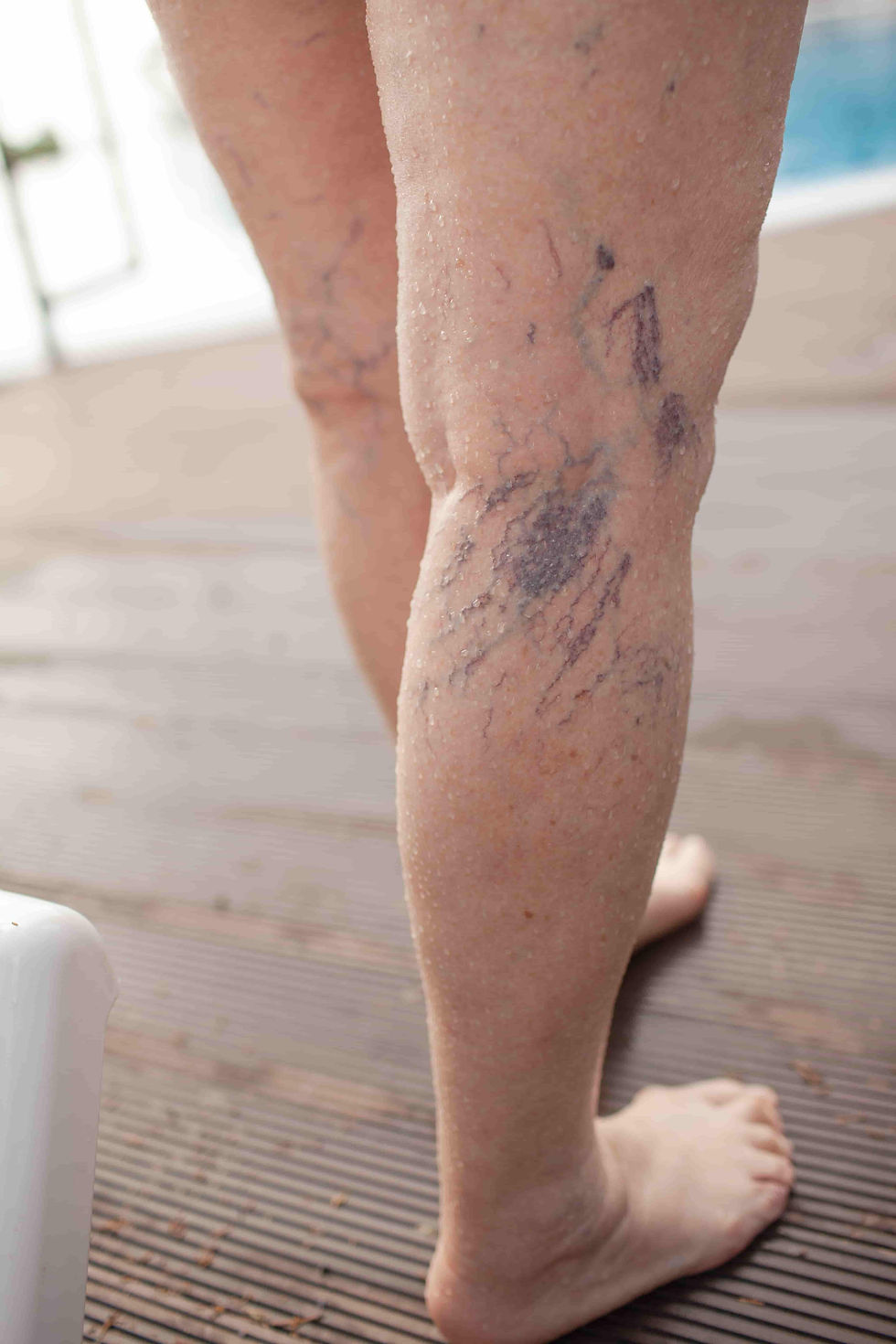Skin changes with varicose vein and venous insufficiency
Skin Changes with Varicose Veins and Venous Insufficiency
Varicose veins can lead to progressive skin changes, particularly in the lower legs, due to chronic venous insufficiency (CVI). As blood pools in the veins and pressure increases, the skin may undergo discoloration, thickening, and inflammation, often indicating worsening vein disease.
Early symptoms include dryness, itching, and mild pigmentation (skin discoloration), but more severe changes such as venous eczema, lipodermatosclerosis (skin hardening), and ulceration may develop over time.
Recognizing these skin alterations is crucial, as they affect appearance and comfort and may signal a higher risk of complications, including venous ulcers. Proper treatment of varicose veins can help prevent or manage these skin changes, improving vascular health and skin condition.
Varicose veins are swollen, twisted blood vessels that appear just under the skin, often in shades of blue or purple and varying in size.
These veins become enlarged due to the weakening of vein walls and the poor functioning of the valves inside the veins (incompetent valves).
You may notice varicose veins more when you’re upright, as they often become less visible when lying down.
This is because gravity causes the leg veins to fill with blood when standing, making them more visible.
Varicose veins commonly occur in the lower half of the body, particularly in the legs. Some patients may also develop them in the hip or pelvic region.
Spider Veins and Thread Veins
Spider veins and reticular veins, though also venous diseases, are narrower and less raised compared to varicose veins.
Spider veins may resemble tree branches or spider webs. They can appear red or blue and are often seen behind the knee, feet, and face.
Spider veins and reticular veins are usually associated with underlying vein problems.

Varicose Eczema
Also known as stasis dermatitis, it is a skin condition that develops due to poor blood flow from underlying varicose veins.
It causes the skin, especially around the lower legs and ankles, to become red, itchy, dry, and discolored.
This happens when weakened veins allow fluid to leak into surrounding tissues, leading to inflammation.
Treatment involves moisturizers, anti-inflammatory creams to soothe the skin, and compression stockings to improve circulation.
Laser varicose veins treatment (EVLT), Radiofrequency ablation (RFA), or sclerotherapy.
To prevent recurrence and achieve lasting results, addressing the root cause is essential by treating the varicose veins with endovenous laser therapy (EVLT), radiofrequency ablation (RFA), or sclerotherapy.
Hyperpigmentation (Skin Discolouration)
Hyperpigmentation refers to dark discoloration of the skin, usually brownish or reddish-brown, caused by the leakage of red blood cells from damaged veins. This is how varicose veins affect skin.
As these cells break down, hemosiderin (an iron pigment) is deposited in the skin, changing the visible color.
Hyperpigmentation, often painless, is an early indicator of venous insufficiency and may lead to more serious complications such as lipodermatosclerosis and skin ulcers if not addressed.


Corona Phlebectatica (Ankle veins)
Corona phlebectatica is a sign of advanced venous insufficiency, marked by a network of dilated, slight, bluish, or reddish veins around the ankle and foot.
These thread-like veins often indicate underlying venous disease and may accompany symptoms like leg heaviness, discomfort, and swelling.
It can progress to skin changes or even skin ulcers if left untreated. This condition requires early treatment of varicose veins.
Lipodermatosclerosis
Lipodermatosclerosis is a condition marked by inflammation, hardening, and thickening of the skin and the tissues beneath it, usually affecting the lower legs and ankles.
The skin in the affected area becomes tight, firm, and discolored, often giving the leg a distinctive shape known as the “inverted champagne bottle” appearance, where the lower leg narrows around the ankle.
This condition develops due to chronic venous pressure and poor circulation, leading to persistent inflammation and fibrosis (tissue scarring).
It can cause significant discomfort or pain and, in advanced stages, may increase the risk of developing skin ulcers.


Venous Leg Ulcer
A venous ulcer is an open, slow-healing wound that usually occurs on the lower leg or ankle due to chronic venous insufficiency.
It develops when poor blood flow causes increased pressure in the veins, leading to skin breakdown.
Venous ulcers often have irregular edges, are shallow, and may be surrounded by swollen, discolored, or thickened skin.
Treatment involves compression therapy, wound care, and addressing the underlying vein problem with procedures like sclerotherapy or endovenous laser therapy (EVLT), radiofrequency ablation, and sclerotherapy to promote healing and prevent recurrence.
Your doctor must rule out any arterial causes of the ulcer. Dr. Soroush Sohrabi, in Dubai, performs a comprehensive vascular assessment to evaluate arterial and venous conditions, ensuring that patients receive the most appropriate and effective treatment.
Diagnosis of Skin Changes Associated with Varicose Veins and Venous Insufficiency
Diagnosing skin changes associated with varicose veins and venous insufficiency involves a thorough clinical examination and vascular assessment.
A healthcare provider will evaluate visible skin discoloration, texture changes, and signs of inflammation, such as venous eczema, lipodermatosclerosis, or ulcer formation.
In addition to physical examination, a Doppler ultrasound scan is often performed to assess blood flow, vein function, and the presence of reflux (backward blood flow) in the affected veins. This imaging test helps identify hidden varicose veins or deeper venous issues contributing to skin deterioration.
An early and accurate diagnosis plays a key role in preventing complications and guiding appropriate treatment to restore both vascular function and skin health.
Treatment of Skin Changes Associated with Varicose Veins and Venous Insufficiency in Dubai
Managing skin changes caused by varicose veins involves addressing the underlying venous insufficiency and the associated skin symptoms. Addressing the underlying cause with treatments like endovenous laser ablation (EVLA), radiofrequency ablation (RFA), Clarivein, sclerotherapy, or venous surgery can enhance circulation and reduce the risk of skin complications.
Topical treatments such as moisturizers, corticosteroid creams (for venous eczema), and emollients can help restore the skin’s barrier function and alleviate itching, inflammation, and discoloration.
Compression therapy is also essential, as it reduces swelling and enhances blood flow, slowing the progression of skin changes. In more advanced cases, where lipodermatosclerosis or venous ulcers are present, wound care, medicated dressings, and specialist intervention may be required.
A comprehensive treatment plan combining venous interventions, skincare, and lifestyle modifications is crucial for improving vascular and skin health while preventing long-term complications.
Dr. Soroush Sohrabi’s Dubai advanced vascular assessments and customized treatments target skin changes secondary to varicose veins and venous insufficiency. He addresses the underlying cause and symptoms to prevent complications and restore skin health.



